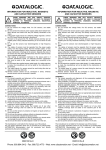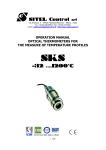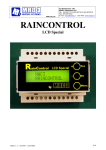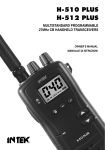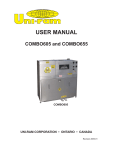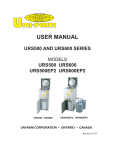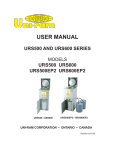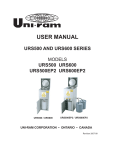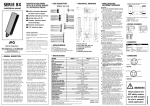Transcript
TECHNICAL DATA US18 SERIES - analog output - Power supply: Ripple: Consumption (load current excluded): Output configurations: Outputs: ultrasonic sensors INSTRUCTION MANUAL CONTROLS Programming push-button (TEACH) This push-button allows to program the reading points of the sensor. PWR LED indicator OFF ON Red ON Green Indicates Power is OFF. Target is weak or outside sensing range. Sensor is operatine normally, good target. OUT LED indicator OFF ON Yellow ON Red (solid) ON Red (flashing) Indicates Target is outside windows limits Target is within windows limits In TEACH mode, waiting for first limit In TEACH mode, waiting for second limit CONNECTIONS Output Response time (for a 95% step change): Max. switching frequency: Range indicator: (Red/Green) Teach/Output indicator: (Yellow/Red) Setting: Delay at Power-up: Temperature effect: Temperature warmup drift: Linearity (note A): Resolution (note A): BROWN 1 BLUE 3 WHITE 2 + 10 … 30 Vdc 0V 4…20 mA or 0…10 Vdc BLACK 4 5…30 Vdc (fast) / 0…2 Vdc (slow) 5 GREY REMOTE TEACH (0…2 Vdc) M12 - 5 POLE CONNECTOR 4 1 5 3 Minimum window size: Ultrasonic emission: Remote teach input: Operating temperature: Storage temperature: Maximum relative humidity: Electrical shock protection: Operating distance (typical values): Vibrations: Reference standard: Shock resistance: Housing material: Threaded barrel material: Push-button material: Light pipes material: Mechanical protection: Connections: Weight: Teaching limits using the Auto-Window feature SENSOR PROGRAMMING US18-PA US18-PR AXIAL VERSION RADIAL VERSION 10 … 30 Vdc (limit values), reverse polarity protection 2 Vpp 65mA max., 40 mA typical @ 25 Vcc 0…10 Vcc (voltage output) or 4…20 mA (current output) overload and short circuit protection Analog voltage output: 2.5 K minimum load resistance. Minimum supply for a full 10V output is 12Vdc (for supply voltages between 10 and 12V, out max is at least V supply - 2) Analog current output: 1K max @ 24V input. Max load resistance = (Vcc-4)/0.02 ohms For current output (4-20mA) models, ideal results are achieved whwn the total load resistance R = [(Vin-3)/0.020]. Example, at Vin = 24V, R 1K (1watt) A worst case shift of 1% of sensing distance is caused by operating the sensor at Vin = 30Vdc and R = 0 2.5 ms (Fast): pin 4 (black wire) at 5…30 Vdc 30 ms (Slow): pin 4 (black wire) at 0…2 Vdc (or not connected) 200 Hz (fast), 16 Hz (slow) Green Target is within sensing range Red Target is outside sensing range OFF Sensing power is OFF Yellow Target is within sensing range OFF Target is outside taught window limits Red Sensor is in Teach mode Sensing window limits: TEACH-Mode programming of near and far window limits may be set using the push button or remotely via TEACH input 300 ms 0.02% of distance/°C less than 1.7% of sensing distance upon power-up 2.5 ms response: 1 mm 30 ms response: 0.5 mm 2.5 ms response: 1 mm 30 ms response: 0.5 mm 5 mm 300 KHz, rep. rate 2.5 ms Impedence: 12 K -20 … 60 °C -25 … 70 °C 100% Class 2 30…300 mm 0.5 mm amplitude, 10…55 Hz frequency, for every axis (EN60068-2-6) EN60947-5-2 11 ms (30 G) 6 shock for every axis (EN60068-2-27) Thermoplastic polyester ABS/PC Santoprene Acrylic IP67 M12 - 5 pole connector 25 g Two TEACH methods may be used to program the sensor: Teach individual minimum and maximum limits. Use Auto-Window feature to center a sensing window around the taught position. The sensor may be programmed either via its push button, or via a remote switch. Remote programming may be used to disable the push button, preventing unauthorized personnel from adjusting the programming settings. To access this feature, connect the Remote Teach wire of the sensor to 0 - 2V dc, with a remote programming switch between the sensor and the voltage. NOTE: The impedance of the Remote Teach input is 12 K. Programming is accomplished by following the sequence of input pulses (see chap. “Normally Open/Normally Closed operation select”). The duration of each pulse (corresponding to a push button “click”), and the period between multiple pulses, are defined as “T”: Teaching the same limit twice for the same output automatically centers a 100mm window on the taught position ( 50 mm). The analog output will be centered on the taught position at approximately 5V or 12mA. Programming procedure TEACH push-button Programming mode Push and hold TEACH push-button No action required; sensor is ready for 1st limit teach OUT LED: ON, Red PWR LED: ON Green (good signal) ON Red (no signal) Position the target for the center of window PWR LED: must be ON Green 0.04 seconds < T < 0.8 seconds Position the target for the center of window TEACH Limit Re-TEACH Limit Indicators LED Remote line (remote teach) “Click” the TEACH push-button Single-pulse the remote line (0.04 s < T < 0.8 s) Without moving the target, “click” the TEACH push-button again Without moving the target, single-pulse the remote line again (0.04 s < T < 0.8 s) TEACH interface Teach accepted: OUT LED, flashing, Red Teach unacceptable: OUT LED, ON Red Teach accepted: OUT LED, Yellow or OFF Teach unacceptable: OUT LED, flashing, Red Analog Output Slope The sensor may be programmed for either a positive or a negative output slope, based on which limit is taught first (see pictures). If the Near limit is taught first, the slope will be positive. If the Far limit is taught first, the slope will be negative. The analog output signal, is automatically distributed over the width of programmed sensing window. In the event of signal loss, the analog output goes to 3.6mA or 0Vdc, which may be used to trigger an alarm. General Notes on Programming The sensor will return to RUN mode if the first TEACH condition is not registered within 120 seconds. After the first limit is taught, the sensor will remain in PROGRAM mode until the TEACH sequence is finished. To exit PROGRAM mode without saving any changes, press and hold the programming push button > 2 seconds (before teaching the second limit). The sensor will revert to the last saved program. TEACH push-button lockout Enables or disables the push button to prevent unauthorized personnel from adjusting the program settings. Programming procedure TEACH push-button TEACH Pushbutton lockout Not available via push-button Remote line (remote teach) 0.04 s < T < 0.8 s Four impulse the remote line Enable/Disable Function Push-button are either enabled or disabled, depending on condition.. Teaching Minimum and Maximum Limits 2 PRINCIPLES OF OPERATION DIMENSIONS Programming procedure AXIAL VERSION TEACH PUSH-BUTTON Ultrasonic sensors emit one or multiple pulses of ultrasonic energy, which travel through the air at the speed of sound. A portion of this energy reflects off the target and travels back to the sensor. The sensor measures the total time required for the energy to reach the target and return to the sensor. The distance to the object is then calculated using the following formula: TEACH push-button PWR LED Programming mode OUT LED Push and hold TEACH push-button Remote line (remote teach) Indicators LED No action required; sensor is ready for 1st limit teach OUT LED: ON, RED PWR LED: ON Green (good signal) ON Red (no signal) Position the target for the first limit PWR LED: must be ON Green 90.9 D = Distance from the sensor to the target C = Speed of sound in air t = Transit time for the ultrasonic pulse 53.8 Position the target for the first limit 18 To improve accuracy, an ultrasonic sensor may average the results of several pulses before outputting a new value. Temperature Effects TEACH First limit The speed of sound is dependent upon the composition, pressure and temperature of the gas in which it is traveling. For most ultrasonic applications, the composition and pressure of the gas are relatively fixed, while the temperature may fluctuate. In air, the speed of sound varies with temperature according to the following approximation: Cm/s = Speed of sound in meters per second Tc = Temperature in °C “Click” the TEACH push-button mm Teach unacceptable: OUT LED, ON Red RADIAL VERSION TEACH PUSH-BUTTON PWR LED Temperature Compensation Position the target for the second limit Position the target for the second limit “Click” the TEACH push-button Single-pulse the remote line (0.04 s < T < 0.8 s) TEACH Second limit 95.1 58 18 NOTES: Exposure to direct sunlight can affect the sensor’s ability to accurately compensate for changes in temperature. If the sensor is measuring across a temperature gradient, the compensation will be less effective. The temperature warmup drift upon power-up is less than 1.7% of the sensing distance. After 10 minutes, the apparent distance will be within 0.3% of the actual position. After 25 minutes, the sensing distance will be stable. OUT LED 3.6 Changes in air temperature affect the speed of sound, which in turn affects the distance reading measured by the sensor. An increase in air temperature shifts both sensing window limits closer to the sensor. Conversely, a decrease in air temperature shifts both limits farther away from the sensor. This shift is approximately 3.5% of the limit distance for a 20° C change in temperature. The US18 series ultrasonic sensors are temperature compensated. This reduces the error due to temperature by about 90%. The sensor will maintain its window limits to within 1.8% over the -20° to +60°C range. Single-pulse the remote line (0.04 s < T < 0.8 s) Teach accepted: (Sensor learns the 0Vdc or 4mA limit) OUT LED, flashing Red PWR LED: must be ON Green Teach accepted: (Sensor learns the 10Vdc or 20mA limit) OUT LED, Yellow or OFF Teach unacceptable: OUT LED, flashing Red 8.5 NOTE: The duration of each pulse (corresponding to a push button “click”), and the period between multiple pulses, are defined “T” (0.04 s < T < 0.8 s). Phone: 800.894.0412 - Fax: 888.723.4773 - Web: www.ctiautomation.net - Email: [email protected] DECLARATION OF CONFORMITY We DATALOGIC AUTOMATION declare under our sole responsibility that these products are conform to the 2004/108/CE and successive amendments. WARRANTY DATALOGIC AUTOMATION warrants its products to be free from defects. DATALOGIC AUTOMATION will repair or replace, free of charge, any product found to be defective during the warranty period of 36 months from the manufacturing date. This warranty does not cover damage or liability deriving from the improper application of DATALOGIC AUTOMATION products. DATALOGIC AUTOMATION cares for the environment: 100% recycled paper. DATALOGIC AUTOMATION reserves the right to make modifications and improvements without prior notification. Datalogic and the Datalogic logo are registered trademarks of Datalogic S.p.A. in many countries, including the U.S.A. and the E.U. 826002203 Rev.C © Copyright Datalogic 2007-2010
